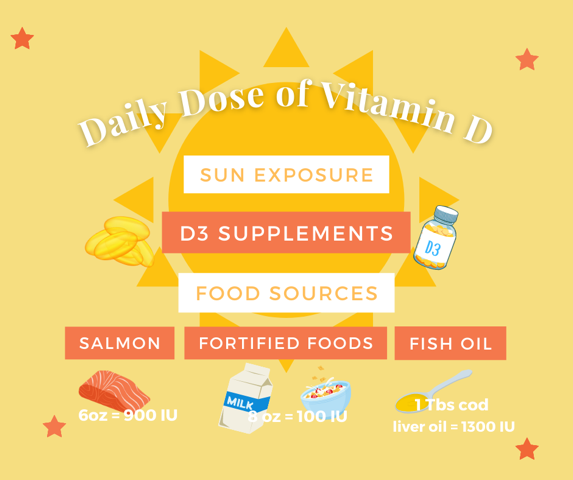We’re in that time of year where the days are short and we often see little daylight, if any. Our vitamin D stores are running low and it’s that much harder to make more.
Vitamin D plays such an important role in so many functions of our body. It plays a role in calcium balance, immune function, cell differentiation, insulin secretion, and blood pressure regulation.(1) Deficiencies in vitamin D most notably are seen as bone malformation in children, rickets, and osteoporosis in adults.(2) Numerous studies have shown a strong association between vitamin D deficiency and the development of cancer, cardiovascular disease, insulin-dependent diabetes, autoimmune diseases and depression.(1,2)
Vitamin D is mainly absorbed through the skin from sunlight. It’s recommended to expose 40% of skin to sun twenty minutes a day to prevent vitamin D deficiency. (3) Factors such as the season, the time of day, where you live, cloud cover and pollution affect the amount of UVB that reaches your skin. This can be an additional challenge for some. People with darker skin pigmentation, older people, and people who use sunscreen. I’m sorry to say, for us New Englanders the sun is not enough.
Including dietary sources of vitamin D is important to offset the lack of production from sun exposure. Vitamin D is a fat-soluble vitamin. Sources of vitamin D are found in fatty fish such as salmon, mackerel, and tuna, as well as fortified foods such as orange juice, milk, and breakfast cereals. However, individuals with malabsorption disorders, such as celiac disease, inflammatory bowel disease, gastric bypass, and chronic pancreatic insufficiency may not be able to absorb enough vitamin D from food sources.(2-4) Fat absorption is also affected in aging populations therefore putting them at greater risk for deficiency.(2,3)
This is one of those rare occasions where I find supplementation necessary. However, much like iron supplementation, it’s important to have your levels tested before popping the pills. I recommend you ask your doctor at your next physical to test your serum 25-hydroxyvitamin D3 or 25(OH)D levels to get your current status. Unfortunately, many doctors don’t regularly test your D levels when they run a blood panel. Ask for it, it can be worth the extra money to know where you should start with your supplementation. The recommended preventative dose of D3 is 600-800 IU.(2) For many this is not enough and a much higher IU is recommended.(2,4) However, with many fat-soluble vitamins, toxicity is also a concern. Test, don’t guess. Remember there are additional factors that need to be considered, and the season can also affect your current levels.
References:
1. R. Lord and J. A Bralley. Laboratory Evaluations for Integrative and Functional Medicine. Metametrix. 2012.
2. Sizar O, Khare S, Goyal A, et al. Vitamin D Deficiency. [Updated 2022 Jul 27]. In: StatPearls [Internet]. Treasure Island (FL): StatPearls Publishing; 2022 Jan-. Available from: https://www.ncbi.nlm.nih.gov/books/NBK532266/
3. Naeem Z. Vitamin d deficiency- an ignored epidemic. Int J Health Sci (Qassim). 2010 Jan;4(1):V-VI.
4. https://www.health.harvard.edu/staying-healthy/time-for-more-vitamin-d

